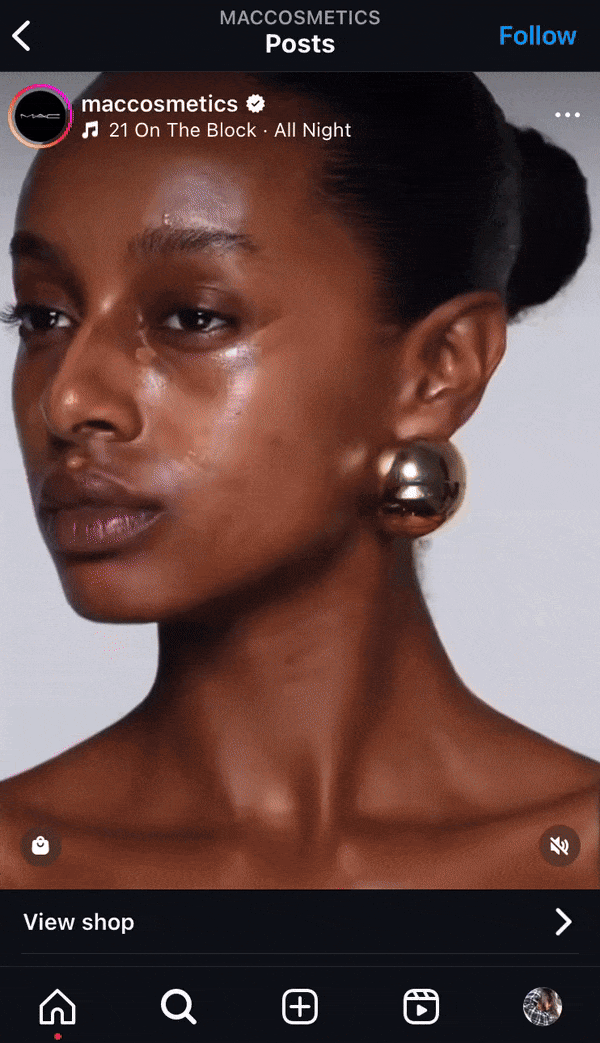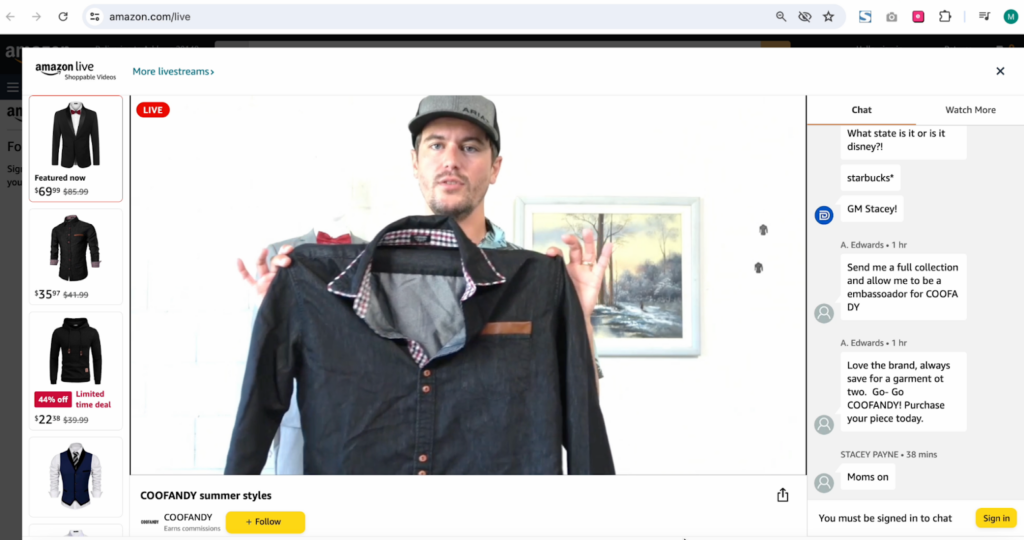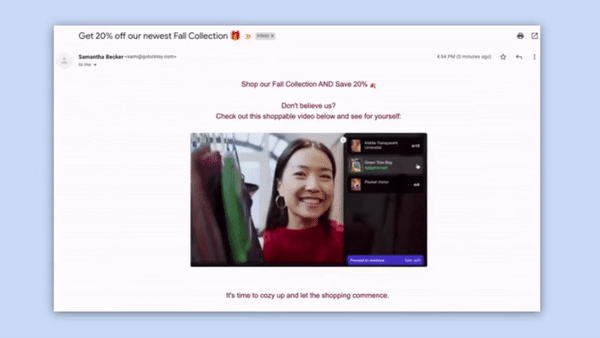E-commerce has come a long way. Not long ago, online shopping meant endless scrolling through static images and dry product descriptions. No video. No interaction. Just guesswork.
Now, you’re shopping online, but instead of scrolling through static images and text, you’re watching a livestream.
The product comes to life as a real human (host) explains its features, and you get a clear sense of how it might fit into your life.
And it feels almost like a personal shopping experience, a virtual walkthrough of your favorite store, from the comfort of your home.
This is video commerce.
As consumers increasingly demand instant gratification and authentic interactions, traditional e-commerce is starting to feel a little outdated.
Video commerce is stepping in to fill that gap.
- What is Video Commerce?
- How to include video commerce to your marketing channels?
- Types of Video Commerce
- The Evolution of Live Commerce From Traditional E-commerce
- The Impact of Video Commerce on E-commerce
- How Video Commerce is Redefining Online Shopping
- How to Effectively Use Video in E-Commerce
- Video Commerce Best Practices
- The Future of Video Commerce
What is Video Commerce?
Video commerce involves using shoppable videos to demonstrate products, tell stories, and engage and convert customers in ways traditional e-commerce can’t.
It’s already popular in China and is spreading like wildfire in the US with brands pouring their money in on it.
Video commerce is super important for brands and retailers because video has a powerful impact on buying decisions.
89% of buyers, that’s nearly 9 out of 10, want brands to share more video content. While 82% of them have bought a product after watching a video.
How to include video commerce to your marketing channels?
You’ll need an e-commerce platform that supports video commerce features and functionalities.
Then using the tools and plugins of that platform, integrate shoppable videos and enable video checkouts on your:
- Website’s homepage.
- Product pages of your ecommerce site.
- Email campaigns.
- Social media like TikTok, Twitch, YouTube, Instagram.
- Marketplaces like Amazon, Walmart.
- Video ads.
Types of Video Commerce
Video commerce comes in many forms, both live and pre-recorded.
Live commerce is when a video streams in real time, and customers can join in, ask questions to the hosts, and buy products right on the spot.
Then there’s non-live commerce, which is pre-recorded and can be watched anytime. Like this Instagram Reels with product tags:

The Evolution of Live Commerce From Traditional E-commerce
Remember when TV took over from radio?
And then the days of Home Shopping Network and QVC events on the television?
Back then users could place an order while watching the shows, but for that, they needed to call at a specific number shown on the TV screen.
Then decades later, came social media. Facebook democratized photo sharing. Then came Instagram.
Businesses and consumers already started using social media for selling and buying products.
In those days, mainly static images were used, and buyers were asked to click the link in bio or a link in the post to visit a dedicated website for purchase.
Then TikTok joined and everything changed.
We started seeing more and more shoppable videos on social media.
YouTube’s transition from a video-sharing platform to a video-based e-commerce platform happened recently.
Realizing the potential of online shopping, brands started integrating shoppable videos into their websites and e-commerce storefronts.
Now even Walmart, Amazon have enabled livestream shopping to take advantage of video commerce.
The Impact of Video Commerce on E-commerce
Video commerce has improved online shopping for the better. Instead of just reading about a product, people can see it in action, which makes a big difference.
When customers watch a video, they can understand how a product works, see its details, and get a better sense of its quality. This builds trust and helps them make quicker decisions . Plus, during live stream, creators and brands can answer questions that text and images just can’t.
The result? More sales, fewer returns, and happier customers.
Video commerce is making online shopping more interactive, and that’s leading to a better experience for everyone involved. Brands are seeing significant results, boosting sales with shoppable videos, and allowing consumers to purchase products directly from the video content they are watching.
Let’s take a look at these statistics:
- E-commerce product pages with videos can convert up to 80% more than pages without video content.
- 97% of consumers say they are more likely to buy a product after watching a video that explains how it works.
- 73% of consumers are more likely to make a purchase after watching a video that explains a product or service.
- 58% of consumers believe that companies with product videos are more trustworthy.
- 44% of consumers prefer to watch a video to learn about a product.
- Shoppers who watch a product video are 144% more likely to add it to their cart compared to those who don’t.
- Consumers are four times more likely to watch a product video than read its description.
- 74% of people who watched a product explainer video ended up buying the product.
- 44% of consumers would buy more than one product after watching a product video.
- Product pages with videos see 37% more add-to-cart conversions than pages without videos.
- 52% of consumers feel more confident in their online purchase decisions after watching product videos.
- Visitors who watch product videos are 85% more likely to make a purchase than those who don’t.
How Video Commerce is Redefining Online Shopping
Building Trust and Authenticity
Videos are fantastic for showcasing product quality and authenticity. User-generated content and testimonials can further build trust.
When customers see real people using and loving your products, it adds a layer of credibility that static images and text simply can’t match.
See below how Stormi Steele uses user-generated content effectively:
@iamstormisteele #duet with @Lush October #bodyglaze i literally hold my breath wayching reviews… and faint when people dont dig in and put it on before judging lol 🙈🙈🙈
♬ original sound – Lush October
Educational Content
Instructional videos and how-to guides are invaluable. They not only educate customers but also enhance their overall experience.
That’s why 88% of marketers agree that videos enhance user understanding of their products or services.
Brands that use educational content effectively can create a loyal customer base that sees them as a trusted resource.
Here’s a shoppable video (shop tag can be viewed from the mobile app) from Sephora that does exactly that:
Enhanced Customer Engagement
Videos make shopping more engaging, keeping customers on your site longer and encouraging them to interact more.
For instance, brands that use video content see a significant increase in time spent on their sites and higher interaction rates.
It’s simple: videos capture attention and hold it, making your online store more memorable.
Improved Conversion Rates
The impact of live video commerce on conversion rates is deep. When customers see products in action, they’re more likely to make a purchase.
Statistics show that brands using video content can experience a substantial boost in sales.
Whether it’s a product demo or a live Q&A session, video content drives conversions like nothing else.
Stormi Steele’s $1M sales during TikTok Live is a testimony to that.
@iamstormisteele BLUEPRINT 🤯. To be the FIRST person and brand to accomplish this epic feat and being a part of TIKTOK history is a dream come true! Add being a BLACK FEMALE from a no stoplight town learning on her own on top of that just makes it that much sweeter!!! And now I’m excited to help find other amazing brands find success on TIKTOK as well!! That’s what CANVAS BEAUTY is all about! That’s the why! My obedience is connected to soo many other people’s destiny and I take that to heart the LONNNGGGG WAY!!! oh and btw why if you ain’t on BODY GLAZE by now, let me tell you, it’s time!!!
♬ original sound – CANVAS BEAUTY BRAND
SEO benefits
Using videos in your e-commerce strategy isn’t just good for engagement; it’s great for improving your search rankings too.
Search engines love video content because it keeps people on a page longer, which signals that the content is valuable. When videos are optimized with the right keywords, titles, and descriptions, they can rank higher in search results, making it easier for potential customers to find your products.
Videos can also appear in Google’s video search, giving your brand extra visibility. Plus, people are more likely to share videos, which increases backlinks and boosts your SEO even more.
How to Effectively Use Video in E-Commerce
1. Product videos on your website
Whether you have an online e-commerce store or a website, integrating video commerce into home page and product pages can significantly boost engagement and conversions.
You can create unboxing videos that allow customers to virtually experience the product or ‘how-to’ videos that show them how to use it.
User-generated videos, like customer testimonials, are also powerful in showing the product in real-world use.
2. FAQ-style videos
Answer frequently asked questions with videos. This gives your brand a voice and allows you to provide more detailed, contextual responses.
Use graphics and visuals in your videos to explain more complex answers. This can make your explanations clearer and more engaging.
3. Shoppable videos
Shoppable videos make it easy for customers to shop directly from videos. Brands can link products within the video, allowing customers to shop immediately or save the product for later.
Show your products in action, whether it’s people wearing your apparel or demonstrating how a product works. This helps customers make more informed decisions.

4. Livestream Shopping
Livestreaming lets you interact with customers in real-time, showcasing products and answering questions on the spot. It’s a great way to create a sense of community and urgency around your products.
Organize live shopping events on your website, marketplaces, social media, or everywhere.

5. Boost Product Launches with Video
Use videos to tease and announce new products. Teasers build anticipation, while in-depth videos can highlight key features and benefits.
Share your launch videos across your website, social media, and email to maximize reach and engagement.
See how Stormi Steele announces product launches on her TikTok and organizes live shopping events to boost sales:
@iamstormisteele Its GOING UP!!!
♬ original sound – CANVAS BEAUTY BRAND
6. Incorporate Videos in Email Campaigns and Newsletters
Videos in emails can break the monotony of text-heavy messages. They can summarize your message quickly, making it easier for recipients to engage.
Videos can increase click-through rates and keep your audience engaged longer with your content.

7. Use Videos in Ads
I come across video ads on social media, Amazon everytime I browse these sites.
These video ads are so engaging that they instantly get me hooked, and sometimes make me open the shop and place an order.
Online video ad spend is forecast to continuously increase. As you can see from the chart below, the world-wide spending on video advertising has gone up each year and in 2024, it’s expected to reach $120b.
The increase in these figures only prove one point: businesses are seeing positive returns from video ads and are going to invest heavily in the future.
So it makes all the sense for you to invest in video ads too.
Want to know which videos work better for your marketing/sales funnel?
Video Commerce Best Practices
Here are some best practices for brands to maximize the impact of video commerce:
1. Optimize for Mobile
Vertical Video Formats: With the rise of mobile shopping, ensure videos are optimized for vertical viewing on smartphones.
Short and Engaging: Capture attention quickly with concise videos that deliver the message within the first few seconds.
2. Incorporate Interactive Elements
Shoppable Videos: Embed clickable links or product tags within the video, allowing viewers to purchase directly from the content.
Live Streaming: Use live video to interact with customers in real-time, answering questions and showcasing products live.
3. Personalize Content
Targeted Messaging: Use data to create personalized video content that speaks directly to different segments of your audience.
Dynamic Content: Tailor video content based on viewer behavior, preferences, or purchase history.
4. Focus on High-Quality Production
Professional Quality: Ensure videos are well-lit, clear, and professionally edited to reflect the brand’s image.
Consistent Branding: Maintain a consistent style, tone, and branding across all video content to build brand recognition.
5. Utilize SEO Strategies
Keyword Optimization: Include relevant keywords in video titles, descriptions, and tags to improve searchability.
Transcripts and Captions: Add transcripts and captions to make videos accessible and improve SEO performance.
6. Test and Analyze Performance
A/B Testing: Experiment with different video formats, lengths, and styles to see what resonates best with your audience.
Analytics: Use video analytics to track engagement, conversion rates, and other key metrics to refine your strategy.
7. Integrate Across Platforms
Omni-Channel Presence: Distribute video content across multiple platforms (social media, website, email) to reach a wider audience.
Platform-Specific Content: Tailor videos to fit the strengths of each platform, whether it’s short clips for Instagram or detailed reviews for YouTube.
8. Tell a Story
Narrative-Driven Content: Use storytelling to create emotional connections with your audience. This helps in making the content more memorable and engaging.
Customer Journeys: Highlight customer stories or case studies that show how your product has made a difference.
The Future of Video Commerce
Emerging Trends
The future of video commerce is bright, with emerging trends like augmented reality, virtual try-ons, and personalized video ads on the horizon. These innovations will make shopping even more immersive and tailored to individual preferences.
Impact of Technological Advancements
Technologies like 5G and AI are set to revolutionize video commerce. Faster internet speeds and smarter algorithms will enhance video quality and personalization, making online shopping more engaging and efficient.
Final Thoughts
Video commerce is not just changing how we shop online.; it’s setting new standards for customer interaction and satisfaction.
Why not make video commerce work for you today?
We at Vimmi, are offering a FREE plan for you to experience the change yourself.
Come, explore the power of shoppable videos and convert customers where they like to shop.
